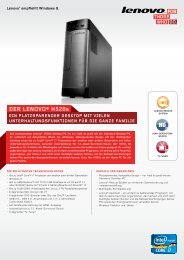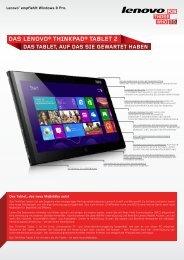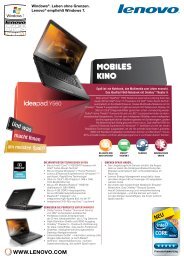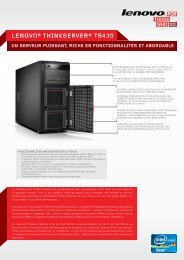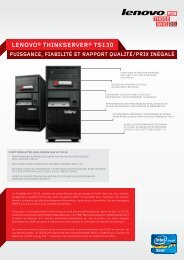You also want an ePaper? Increase the reach of your titles
YUMPU automatically turns print PDFs into web optimized ePapers that Google loves.
3. Right-click on the desktop, and click Screen resolution.<br />
Note: If your computer cannot detect the external monitor, click the Detect button.<br />
4. Set Resolution.<br />
5. Click Advanced Settings.<br />
6. Click the Monitor tab. Check the monitor information window to make sure that the monitor type is<br />
correct. If it is, click OK to close the window; otherwise do as follows.<br />
7. If more than two monitor types are displayed, select Generic PnP Monitor or Generic Non-PnP<br />
Monitor.<br />
8. Click Properties. If you are prompted for an administrator password or confirmation, type the password<br />
or provide confirmation.<br />
9. Click the Driver tab.<br />
10. Click Update Driver.<br />
11. Click Browse my computer for driver software, and then click Let me pick from a list of device<br />
drivers on my computer.<br />
12. Clear the Show compatible hardware check box.<br />
13. Select Manufacturer and Model for your monitor. If you cannot find your monitor in the list, stop the<br />
installation of this driver and use the driver shipped with your monitor.<br />
14. After updating the driver, click Close.<br />
15. Click OK.<br />
Note: To change the color settings, right-click on the desktop, and click Screen resolution. Click Advanced<br />
Settings, select the Monitor tab, then set Colors.<br />
For Windows Vista:<br />
Note: If you select Show different parts of my desktop on each display (extended), refer to “Using the<br />
Extend desktop function” on page 76.<br />
1. Connect the external monitor to the monitor connector, and then connect the monitor to an electrical<br />
outlet.<br />
2. Turn on the external monitor.<br />
3. Press Fn+F7 to change the display output location to the external monitor.<br />
4. Right-click on the desktop, and click Personalize.<br />
5. Click Display Settings. The Display Settings window opens.<br />
6. Click Advanced Settings.<br />
7. Click the Monitor tab. Check the monitor information window to make sure that the monitor type is<br />
correct. If it is, click OK to close the window; otherwise do as follows.<br />
8. If more than two monitor types are displayed, select Generic PnP Monitor or Generic Non-PnP<br />
Monitor.<br />
9. Click Properties. If you are prompted for an administrator password or confirmation, type the password<br />
or provide confirmation.<br />
10. Click the Driver tab.<br />
11. Click Update Driver.<br />
12. Click Browse my computer for driver software, and then click Let me pick from a list of device<br />
drivers on my computer.<br />
13. Clear the Show compatible hardware check box.<br />
14. Select Manufacturer and Model for your monitor. If you cannot find your monitor in the list, stop the<br />
installation of this driver and use the driver shipped with your monitor.<br />
15. After updating the driver, click Close.<br />
Chapter 2. Using your computer 73









